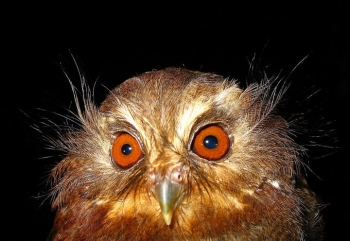
Publisher:
Bonnie King
CONTACT:
Newsroom@Salem-news.com
Advertising:
Adsales@Salem-news.com

~Truth~
~Justice~
~Peace~
TJP
Mar-22-2007 11:39

 TweetFollow @OregonNews
TweetFollow @OregonNews
Long Sought After Bird Spotted in Peruvian Nature Reserve
Salem-News.comEndangered species known only from captured individuals seen in wild for first time.
 Long-whiskered Owlet American Bird Conservancy |
(ALTO NIEVA, Peru) - The extremely rare Long-whiskered Owlet (Xenoglaux loweryi), a species that wasn’t discovered until 1976, and until now was only known from a few specimens captured in nets after dark, has been seen in the wild for the first time by researchers monitoring the Area de Conservación Privada de Abra Patricia – Alto Nieva, a private conservation area in Northern Peru.
The sighting is considered a holy grail of South American ornithology and has not been accomplished in thirty years, despite the efforts of hundreds of birders.
The species is among the world’s smallest owls. It is so distinct that it has been named in its own genus: Xenoglaux meaning “strange owl” on account of the long wispy feathers or whiskers that stream out from its wild-looking reddish-orange eyes. The owl inhabits the dense undergrowth of mountain forests in a remote part of northern Peru.
“Seeing the Long-whiskered Owlet is a huge thrill,” said David Geale of Asociación Ecosistemas Andinos (ECOAN) who was part of the research team. “Its population is estimated to be less than 1,000 birds, and possibly as few as 250. Due to the rapid destruction of its forest habitat and its tiny range, it is inferred that the species is in serious decline. Until recently, the owlet’s key habitat was completely unprotected.”
The Long-whiskered Owlet has previously been captured by researchers on at least three occasions, but until 2002 nothing was known of the bird’s natural history. At that point, calls were recorded from a captive bird, but its biology still remained virtually unknown. Last month, researchers Geale and Juvenal Ccahuana, rangers of Abra Patricia and monitors of the MNBCA program from Alto Mayo, encountered the owlet three times during daylight hours and recorded its calls frequently at night. Several photographs were also taken of a bird captured in a mist-net and later released onto a tree branch where it posed for photographs before disappearing into the night. These additional photos are available at http://www.abcbirds.org/whiskeredowlpic.htm and high resolution copies are available upon request.
“The creation of the Area de Conservación Privada de Abra Patricia – Alto Nieva, located in the Northern end of the Peruvian Yungas ecosystem, provides protection for the key site for the Long-whiskered Owlet,” said Hugo Arnal, American Bird Conservancy’s (ABC) Tropical Andes Program Director. “By establishing a reserve and protecting the owlet’s forest habitat, ABC and its partner ECOAN are giving many other species a chance to survive as well.”
The northeastern section of the Peruvian Yungas, comprises habitat for 317 resident bird species, of which 23 are considered globally threatened. The conservation area also protects much of the known habitat for the endangered Ochre-fronted Antpitta, and has been declared a priority by the Alliance for Zero Extinction. Other endemics in the area include the endangered Royal Sunangel (a hummingbird), the rare and recently-described Johnson’s Tody-Tyrant, and the endangered Ash-throated Antwren.
Several songbirds that breed in North America such as the beautiful Blackburnian Warbler also use these forests during the winter. Other migratory species include the Broad-winged Hawk, Swainson’s Hawk, Swainson's Thrush, and Alder Flycatcher. In total, 29 neotropical migrant species use this area, of which 13 are of conservation concern. Nearly 98% of the reserve consists of well-preserved stands of typical Yungas forests, and it is also considered a rich area for orchids.
ABC’s work in the region is supported by the Gordon and Betty Moore Foundation, Conoco Phillips, the National Fish and Wildlife Foundation, and Robert Wilson. Birdwatchers wishing to search for the owl should contact Hugo Arnal at American Bird Conservancy (see: www.abcbirds.org ). Access is strictly limited to small groups and the chances of success though better than in the past are still considered very low for anything but the luckiest groups.
American Bird Conservancy (ABC) is the only 501(c)(3) organization that works solely to conserve native wild birds and their habitats throughout the Americas. ABC is a membership organization that is consistently awarded a top, four-star rating by the independent group, Charity Navigator.
Articles for March 21, 2007 | Articles for March 22, 2007 | Articles for March 23, 2007
Quick Links
DINING
Willamette UniversityGoudy Commons Cafe
Dine on the Queen
Willamette Queen Sternwheeler
MUST SEE SALEM
Oregon Capitol ToursCapitol History Gateway
Willamette River Ride
Willamette Queen Sternwheeler
Historic Home Tours:
Deepwood Museum
The Bush House
Gaiety Hollow Garden
AUCTIONS - APPRAISALS
Auction Masters & AppraisalsCONSTRUCTION SERVICES
Roofing and ContractingSheridan, Ore.
ONLINE SHOPPING
Special Occasion DressesAdvertise with Salem-News
Contact:AdSales@Salem-News.com

googlec507860f6901db00.html



Terms of Service | Privacy Policy
All comments and messages are approved by people and self promotional links or unacceptable comments are denied.
this story isnt worth your time March 29, 2007 12:03 am (Pacific time)
booo, i've had enuff of hearin about stupid dumb owls. DO A STORY ON CUTE FLUFFY KITTENS INSTEAD. bunk story
Anonymous March 28, 2007 8:38 pm (Pacific time)
very intersting
[Return to Top]©2025 Salem-News.com. All opinions expressed in this article are those of the author and do not necessarily reflect those of Salem-News.com.